2017 MERCEDES-BENZ E-CLASS ESTATE warning
[x] Cancel search: warningPage 424 of 585

#
Mak esuret hat theb atter yisc onnected and
ch arge d.
When theb atter yisd ischar ged:
R thee ngine cann otbe star ted.
R thee lectric parking brak ecann otbe released
or applied.
R vehicles with automatic transmission: the
automatic transmission canno tbeshiftedto
position iorj.
% vehicles with automatic transmission: if
th ea utomatic transmission cann otbe shif‐
te dtop osition i,ort he multifunction dis‐
pla yint he instrument clus terd oes no tshow
anything, ha vethev ehicle transpor ted
aw ay( →pag e422). Atow ing vehicle wit hlift‐
ing equipment is requiredforv ehicle trans‐
por tation. *
NO
TEDama gedue to to wing away at
exc essively high speeds or over long dis‐
ta nces The driv
etra in could be damaged when tow‐
ing at excessively high speeds or over long
dis tances. #
Atow ing speed of 50 km/h mus tnot
be exc eeded. #
Atow ing dis tance of 50 km mu stnotbe
exc eeded. &
WARNING Risk of accident whe ntow ing
av ehicle whic histoo heavy
If th ev ehicle being tow- star tedort owed
aw ay is heavier than thep ermissible gross
mass, thef ollowing situations can occur:
R thet ow ing eyem aybecome de tach ed.
R thec ar/t railer combination ma yswe rve
or eve noverturn. #
If ano ther vehicle is tow- star tedor
to we da way,its weight mus tnotexc eed th
ep ermissible gross mass of your own
ve hicle. If
av ehicle mus tbetow-sta rted or towe da way,
its weight mus tnotexc eed thep ermissible gross
mass of thet ow ing vehicle. #
Information on thep ermissible gross weight
of thev ehicle can be found on thev ehicle
identification plat e. #
Vehicles with automatic transmission: do
no to pen thed rive r's door or front passenger
door ,otherwise thea utomatic transmission
automaticall yshifts toposition j. #
Fitthet ow ing eye( →pag e424). #
Attach thet ow bar.
* NO
TEDama gedue toincor rect connec‐
tion #
Onlyconnect thet ow ro pe or towb arto
th et ow ing eyes. #
Deactivat ethe automatic locking mechanism
(→ pag e74). Breakdown assis
tance 421
Page 425 of 585
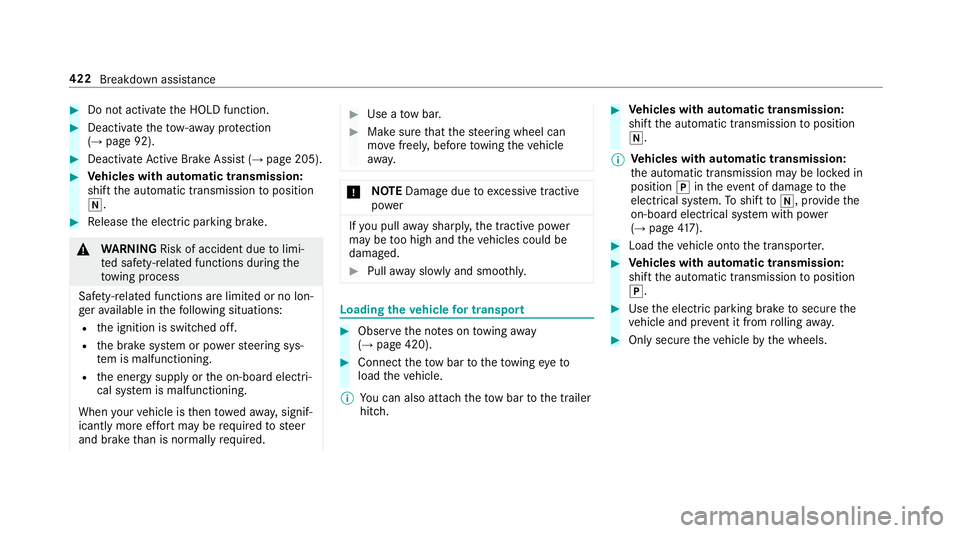
#
Do no tactivate theH OLD function. #
Deactivat ethe tow- aw ay protection
(→ pag e92). #
Deactivat eActiv eBrake Assi st (→pag e205). #
Vehicles with automatic transmission:
shif tthe automatic transmission toposition
i. #
Release thee lectric parking brake. &
WARNING Risk of accident du etolimi‐
te ds afet y-re lated function sduring the
to wing process
Saf ety-re lated function sarelimited or no lon‐
ge ra vailable in thef ollowing situations:
R thei gnition is switched off.
R theb rake system or po wersteering sys‐
te mism alfunctioning.
R thee nergy supply or theo n-boar delectri‐
cal sy stem is malfunctioning.
When your vehicle is then towe da way,signif‐
icantly mor eeffor tm aybe requ ired tosteer
and brak ethan is normall yrequired. #
Use atow bar. #
Mak esuret hat thes teering wheel can
mo vefreely ,befor etow ing thev ehicle
aw ay. *
NO
TEDama gedue toexcessiv etracti ve
po wer If
yo up ullaway sharpl y,thet ractiv epower
ma ybet oo high and thev ehicles could be
damaged. #
Pull away slowl yand smoo thly. Loading the
vehicl efor transport #
Obser vethen otes on towing away
( → pag e420). #
Connec tthe towb arto thet ow ing eyeto
load thev ehicle.
% Youc an also attac hthe towb arto thet railer
hitch. #
Vehicles with automatic transmission:
shif tthe automatic transmission toposition
i.
% Ve
hicles with automatic transmission:
th ea utomatic transmission ma ybelockedin
position jinthee vent of dama getothe
electrical sy stem. Toshif tto i,provide the
on-boar delectrical sy stem wit hpower
( → pag e417). #
Load thev ehicle ont othe transpor ter. #
Vehicles with automatic transmission:
shif tthe automatic transmission toposition
j. #
Use thee lectric parking brak etosecurethe
ve hicle and pr event it from rolling away. #
Onlysecur ethe vehicle bythew heels. 422
Breakdown assis tance
Page 426 of 585
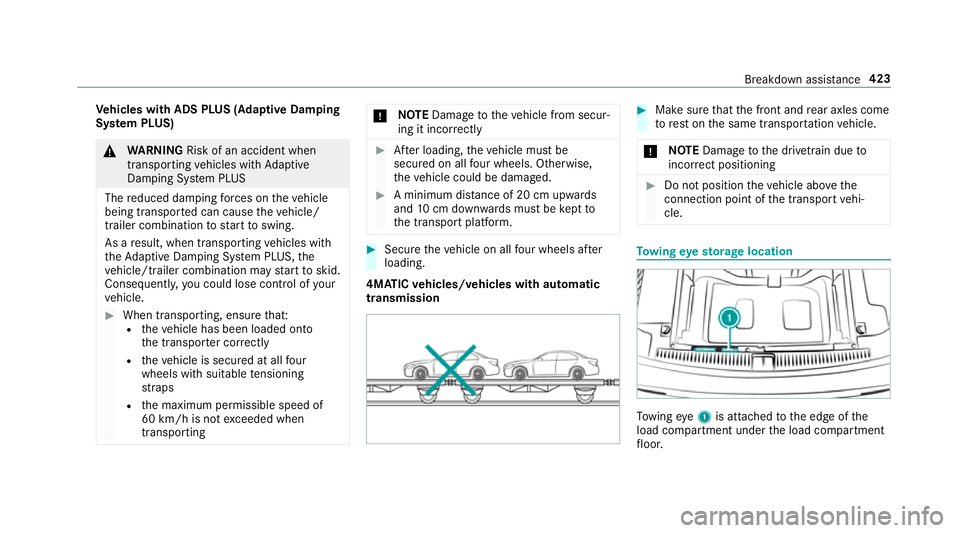
Ve
hicles with ADSP LUS(Ad aptiv eDamping
Sy stem PLUS) &
WARNING Risk of an accident when
transporting vehicles wit hAdaptive
Damping Sy stem PLUS
The reduced damping forc es on thev ehicle
being transpor tedc an cause thev ehicle/
trailer combinatio ntostart to swing.
As aresult, when transporting vehicles with
th eA daptiv eDampin gSystemP LUS,the
ve hicle/trailer combination ma ystart to skid.
Consequentl y,yo uc ould lose cont rolofy our
ve hicle. #
When transporting, ensur ethat:
R thev ehicle has been loaded onto
th et ranspor terc orrectly
R thev ehicle is secured at all four
wheel swiths uitable tensioning
st ra ps
R them aximum permissible speed of
60 km/hisn otexc eeded when
transporting *
NO
TEDama getothev ehicle from secur‐
ing it incor rectly #
Afterl oading, thev ehicle mus tbe
secured on all four wheels. Otherwise,
th ev ehicle could be damaged. #
Am inimum dis tance of 20 cm up wards
and 10cm down wardsm ustbek eptto
th et ranspor tplatform. #
Secur ethe vehicle on all four wheel safter
loading.
4MATIC vehicles/ vehicles with automatic
transmission #
Mak esuret hat thef ront and rear axle scome
to rest on thes ame transpor tatio nv ehicle.
* NO
TEDama getothed rive trai ndueto
incor rect positioning #
Do no tposition thev ehicle abo vethe
connection point of thet ranspor tvehi‐
cle. To
wing eyes torage location To
wing eye1is attached tothee dgeoft he
load compartment under thel oad compartment
fl oor. Breakdown assis
tance 423
Page 427 of 585

Ve
hicles with folding benc hseat: thet ow ing
ey eisl ocated under acove r. Installin
gthe towing eye #
Press them arkonc over 1 inwa rdsa nd
re mo ve. #
Screw inthet ow ing eye clockwise as farasit
willgoa nd tighten. Ve
hicles with atrailert owhitch: vehicles with
at railer hitc hdonothave arear brac ketfor the
to wing eye. Fasten thet ow bar tothet railer tow
hitch.
% Mak esuret hat co ver1engages in the
bumper when your emo vethet ow ing eye.
* NO
TEDama gedue toincor rect us eof
th et ow ing eye When
atow ing eyeisu sedtoreco verav ehi‐
cle, thev ehicle ma ybedamaged in thep roc‐
ess. #
Onlyusethet ow ing eyetot owaway or
to ws tartthe vehicle. To
w- starting thev ehicle (emer gency engine
st arting) Ve
hicles with automatic transmission
* NO
TEDama getothea utomatic trans‐
mission due to tow-starting The automatic transmissio
nmaybe damaged
in thep rocess of tow- startin gvehicles with
automatic transmission. #
Vehicles wit hautomatic transmission
mus tnotbe tow- star ted. #
Vehicles wit hautomatic transmission must
no tbet ow-sta rted. Electrical fuses
Note
sone lectrical fuses &
WARNING Risk of accident and inju ry
due to ov erloaded lines
If yo um anipulat eorbridg eaf aulty fuse or if
yo ur eplace it wit hafuse wit hahigher 424
Breakdown assis tance
Page 429 of 585
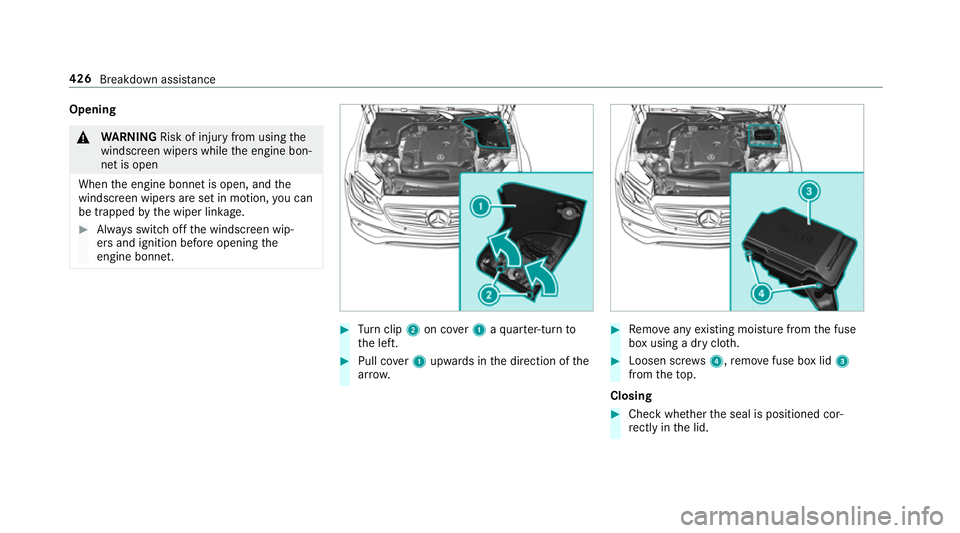
Opening
&
WARNING Risk of inju ryfrom using the
windscreen wiper swhile thee ngine bon‐
ne tiso pen
When thee ngine bonn etis open ,and the
windscreen wiper saresetinm otion, youc an
be trapped bythew iper linkage. #
Alw ayss witc hoffthew indscreen wip‐
er sa nd ignition befor eopening the
engine bonn et. #
Turn clip 2on co ver1aquar ter-tur nto
th el eft. #
Pull co ver1upwards in thed irection of the
ar row. #
Remo veanye xisting moistu refrom thef use
bo xu sing adryclo th. #
Loosen scr ews4,remo vefuse bo xlid 3
from thet op.
Closing #
Chec kwhether thes eal is positioned cor‐
re ctly in thel id. 426
Breakdown assis tance
Page 431 of 585
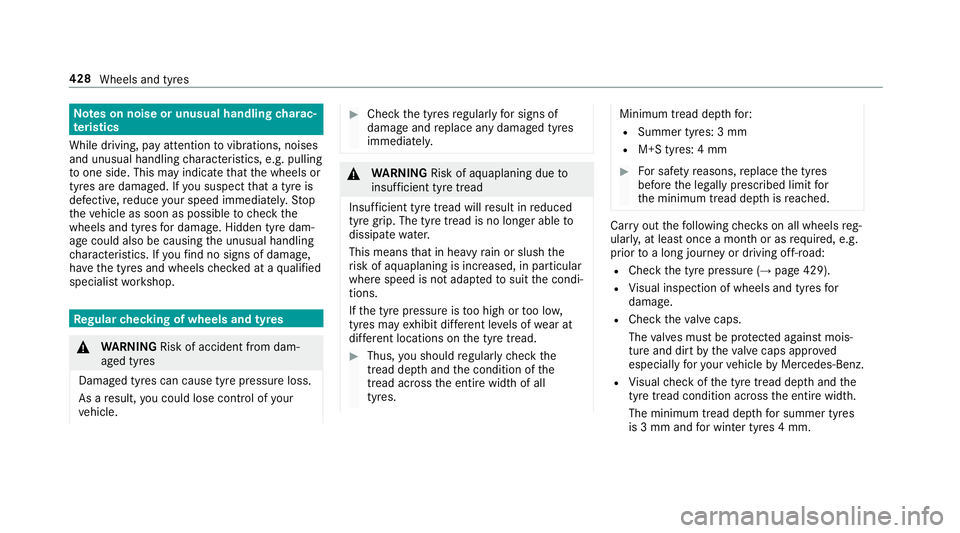
Note
sonn oise or unusua lhandling charac‐
te rist ics
While driving ,pay attention tovibrations, noises
and unusual handling characteristics, e.g .pulling
to one side. This ma yindicat ethat thew heels or
tyres ar edamaged. If yous uspect that at yreis
defective, reduce your spee dimmediatel y.Stop
th ev ehicle as soon as possible tocheckt he
wheels and tyres ford ama ge.H idden tyr edam‐
ag ec ould also be causing theu nusual handling
ch aracteristics. If youf ind no sign sofdamage,
ha ve thet yres and wheels checkedataq ualified
specialis tworks hop. Re
gular checking of wheels and ty res&
WARNING Risk of accident from dam‐
aged tyres
Dama gedt yres can cause tyr epressur eloss.
As aresult, youc ould lose cont rolofy our
ve hicle. #
Chec kthe tyres regularly fors igns of
dama geand replace an ydamaged tyres
immediatel y. &
WARNING Risk of aquaplaning du eto
insuf ficient tyr etread
Insu fficien ttyret read will result in reduced
tyr eg rip. The tyr etread is no longer able to
dissipat ewater.
This mean sthat in heavy rain or slush the
ri sk of aquaplaning is increased, in particular
wher espeed is no tadap tedtos uitthec ondi‐
tions.
If th et yrep ressur eist oo high or tool ow,
tyres ma yexhibit dif fere nt le vels of wear at
dif fere nt locations on thet yret read. #
Thus, yous hould regularly checkt he
tread dep thand thec ondition of the
trea dacross thee ntir ew idthofa ll
tyres. Minimum tread dep
thfor:
R Summer tyres: 3mm
R M+S tyres: 4mm #
Fors afet yr easons, replace thet yres
befor ethe legally prescribed limit for
th em inimum tread dep thisreached. Car
ryout thef ollowing checks on all wheels reg‐
ularly ,atleastonce amonthorasr equired, e.g.
prior toalon gjou rney or drivin goff-roa d:
R Chec kthe tyr epressur e(→pag e429).
R Visual inspection of wheels and tyres for
damage.
R Chec kthe valvec aps.
The valves mus tbeprotected agains tmois‐
tur ea nd dir tbythevalvec aps appr oved
especially fory our vehicle byMercedes-Benz.
R Visual checkoft he tyr etread dep thand the
tyr etread condition across thee ntir ew idth.
The minimum tread dep thfors ummer tyres
is 3mma ndforw inter tyres 4mm. 428
Wheel sand tyres
Page 432 of 585
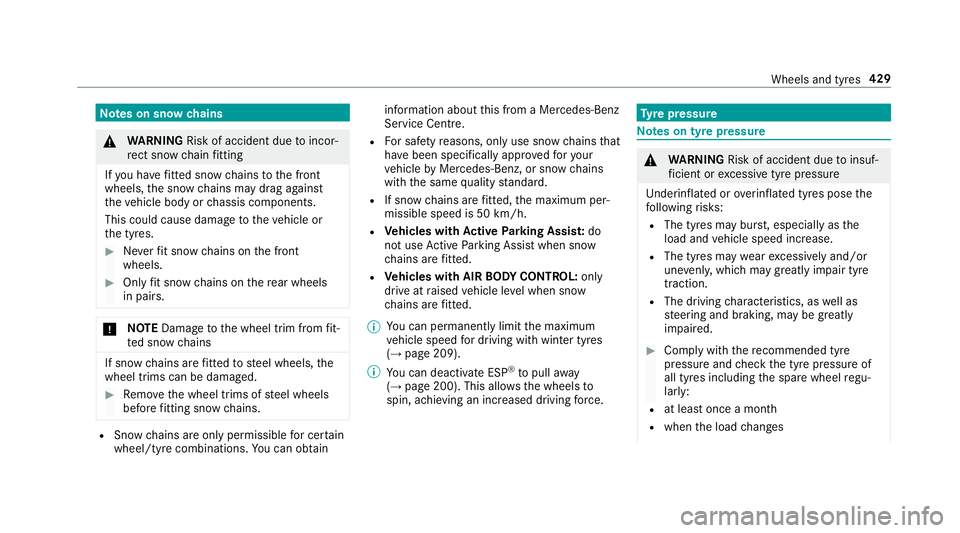
Note
sons nowc hains &
WARNING Risk of accident du etoincor‐
re ct sno wchain fitting
If yo uh ave fitted sno wchains tothef ront
wheels, thes nowc hains ma ydraga gainst
th ev ehicle body or chassis components.
This coul dcaus edamag etothevehicle or
th et yres. #
Neverfit sn ow ch ains on thef ront
wheels. #
Onlyfit sn ow ch ains on ther ear wheels
in pairs. *
NO
TEDama getothew heel trim from fit‐
te ds nowc hains If sno
wchains ar efitted tosteel wheels, the
wheel trims can be damaged. #
Remo vethew heel trims of steel wheels
befor efittin gsnowc hains. R
Sno wchains ar eonly pe rmissible forc ertain
wheel/tyr ecombinations .You can obtain information aboutt
his fromaMercedes-Benz
Service Cent re.
R Fors afet yr easons, onl yuse sn owchains that
ha ve been specifically appr ovedfor your
ve hicle byMercedes-Benz, or sno wchains
wit hthe same qualit ystandard.
R If sn owchains ar efitted, them aximum per‐
missible speed is 50 km/h.
R Vehicles with Activ eP arking Assis t:do
no tu se ActiveP arking Assis twhen snow
ch ains ar efitted.
R Vehicles with AIRB ODYC ONT ROL:only
driv eatr aised vehicle le velw hen snow
ch ains ar efitted.
% Youc an permanentl ylimit them aximum
ve hicle speed ford riving wit hwinter tyres
(→ pag e209).
% Youc an deactivat eESP®
to pull away
( → pag e200). This allo wsthew heels to
spin, achieving an increased driving forc e. Ty
re pressure Note
sont yrep ressure &
WARNING Risk of accident du etoinsuf‐
fi cient or excessiv etyrep ressure
Underinfla tedoro verinfla tedt yres pose the
fo llowing risks:
R The tyres ma yburst,e speciall yasthe
load and vehicle speed increase.
R The tyres ma ywear excessivel yand/or
une venly, whic hmaygreatly impair tyre
traction.
R The drivin gcharacteristics, as well as
st eering and braking, ma ybegreatly
impaired. #
Comply wit hthe recommended tyre
pressur eand checkt he tyr epressur eof
all tyres including thes par ew heel regu‐
larly:
R at leas tonce amonth
R when thel oad changes Wheels and tyres
429
Page 433 of 585
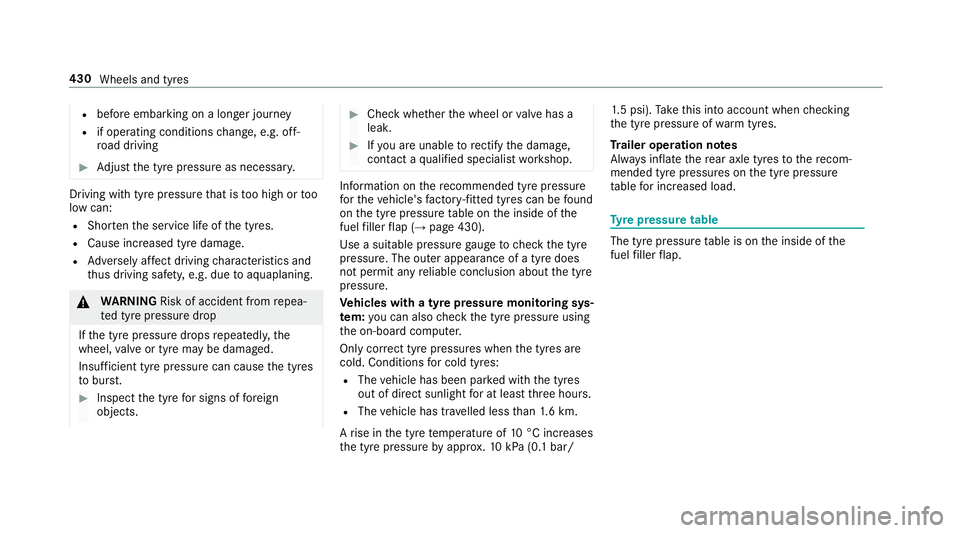
R
befor eembarkin gonalonger journey
R if operating condition schange, e.g. off-
ro ad driving #
Adjus tthe tyr epressur easn ecessar y. Driving wi
thtyr ep ressur ethat is tooh igh or too
lo wc an:
R Sho rten thes ervice lif eofthe tyres.
R Cause increased tyr edamage.
R Adverselya ffect driving characteristic sand
th us drivin gsafet y, e.g. due toaquaplaning. &
WARNING Risk of accident from repea‐
te dt yrep ressur edrop
If th et yrep ressur edrops repeatedl y,the
wheel, valveort yrem aybe damaged.
Insuf ficient tyr epressur ecan cause thet yres
to bur st. #
Inspect thet yref or signs of fore ign
objects. #
Chec kwhether thew heel or valveh as a
leak. #
Ifyo ua reunable torectify thed amage,
conta ctaq ualified specialis tworks hop. Information on
ther ecommende dtyrep ressure
fo rt he vehicle's factor y-fitted tyres can be found
on thet yrep ressur etable on thei nside of the
fuel filler flap (→ page430).
Use asuitable pressur egaug etoc heckthe tyre
pressure. The outer appearance of atyred oes
no tp ermit an yreliable conclusion about thet yre
pressure.
Ve hicles with atyrep ressur emonitoring sys‐
te m: youc an also checkt he tyr epressur eusing
th eo n-boar dcomputer.
Onl ycorrect tyr epressures whe nthe tyres are
cold. Conditions forc old tyres:
R The vehicle has been par kedw itht he tyres
out of direct sunlight foratl east thre eh ours.
R The vehicle has tr avelled less than 1.6k m.
Ar ise in thet yret emperatur eof10°Ci ncreases
th et yrep ressur ebya pprox.10k Pa(0.1b ar/ 1.
5p si).Tak et his int oaccount when checking
th et yrep ressur eofw armt yres.
Tr aile roperation no tes
Alw aysi nflat ethe rear axle tyres tother ecom‐
mended tyr epressures on thet yrep ressure
ta ble fori ncrease dload. Ty
re pressur etable The tyr
epressure table is on thei nside of the
fuel filler flap. 430
Wheels and tyres